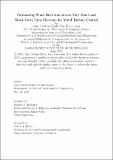| dc.contributor.advisor | Howland, Michael F. | |
| dc.contributor.author | Fiallo Van Eenenaam, Ana Cristina | |
| dc.date.accessioned | 2023-08-23T16:12:09Z | |
| dc.date.available | 2023-08-23T16:12:09Z | |
| dc.date.issued | 2023-06 | |
| dc.date.submitted | 2023-08-04T19:30:33.102Z | |
| dc.identifier.uri | https://hdl.handle.net/1721.1/151831 | |
| dc.description.abstract | Wind energy systems will require improved efficiency to meet future electricity demands in alignment with net-zero goals. Wind turbine yaw control systems can provide incremental improvements in power efficiency across both individual turbines and the collective wind farm. Yaw control strategies commonly apply low-pass őlters of wind directions observed by the turbine in the most recent 10 minutes to determine turbine reactions to the incident wind, yet the inability to anticipate future changes in wind direction lead to suboptimal power production. While recent literature has explored wind speed and power forecasting, methods speciőc to forecasting wind direction are studied less frequently. This thesis utilizes high resolution LiDAR data provided by the Woods Hole Oceanographic Institute Air-Sea Interaction Tower to assess the predictive performance of three methods for deterministic wind direction forecasting: persistence, autoregressive moving average (ARMA), and ridge regression. The models were tested on several time horizons (Δ𝑇) that are relevant to turbine control and operation, ranging from 30 seconds to 2 hours. In this thesis, persistence demonstrated the highest predictive accuracy among the three models across all evaluated timescales. Generally, for Δ𝑇 < 5 minutes, ARMA was next in best performance and outperformed ridge regression. For Δ𝑇 > 5 minutes, ridge regression outperformed ARMA forecasting but was still worse than persistence. Lastly, a comparison of model forecasting performance across several elevations demonstrated inconsistent results across the testing frameworks employed in this thesis, suggesting that future work should continue evaluating models’ performance across heights. Future work should also further develop deterministic and stochastic, data-driven strategies for wind direction forecasting across short term time horizons, as well as assess their impact on individual turbine and farm power efficiency. | |
| dc.publisher | Massachusetts Institute of Technology | |
| dc.rights | In Copyright - Educational Use Permitted | |
| dc.rights | Copyright retained by author(s) | |
| dc.rights.uri | https://rightsstatements.org/page/InC-EDU/1.0/ | |
| dc.title | Forecasting Wind Direction Across Very Short and
Short Term Time Horizons for Wind Turbine Control | |
| dc.type | Thesis | |
| dc.description.degree | M.Eng. | |
| dc.contributor.department | Massachusetts Institute of Technology. Department of Civil and Environmental Engineering | |
| mit.thesis.degree | Master | |
| thesis.degree.name | Master of Engineering in Civil and Environmental Engineering | |
